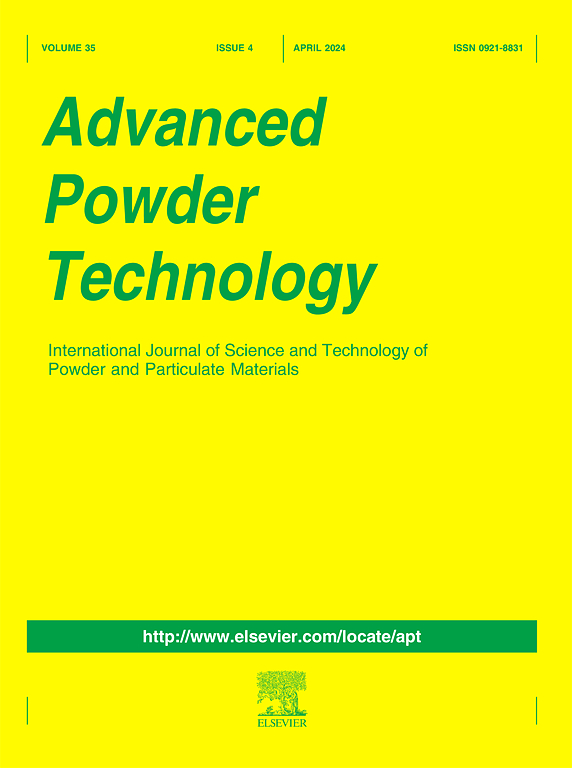非均质颗粒的力学行为与破碎特性研究:实验与数值模拟
IF 4.2
2区 工程技术
Q2 ENGINEERING, CHEMICAL
引用次数: 0
摘要
颗粒破碎通常发生在颗粒状材料中,并影响其结构和力学性能。为了研究非均质颗粒的力学行为和破碎特性,本研究通过室内试验和数值模拟对非均质颗粒进行了宏观微观分析。室内试验结果表明,单颗粒破碎强度和破碎形态具有明显的粒度效应。在数值模拟中,采用高斯分布和Voronoi镶嵌法构建了非均质可破碎颗粒模型,将非均质程度(δ)定义为标准差与期望值之比。数值结果表明,破碎强度的尺寸效应主要是由非均质性引起的。非均质性降低了颗粒的抗压强度。随着δ值的增大,颗粒的力-位移曲线表现出更强的非线性特征,宏观破坏模式由脆性破坏转变为韧性破坏。此外,随着δ的增大,子颗粒之间的变形协调性降低,导致局部应力集中增强,导致裂纹起裂应力降低。这种变化导致裂纹扩展模式由锐角向钝角演化,最终决定了颗粒的破碎强度和破碎模式。本文章由计算机程序翻译,如有差异,请以英文原文为准。

Investigation of heterogeneous particles on mechanical behavior and crushing characteristics: Experiment and numerical simulation
Particle crushing usually occurs in granular materials and affects their structural and mechanical properties. To investigate the mechanical behavior and crushing characteristics of heterogeneous particles, this study conducts both laboratory tests and numerical simulations for a macro-microscopic analysis of the heterogeneous particles. The laboratory tests results demonstrate that the single particle crushing strength and crushing pattern have obvious size effect. In numerical simulations, the heterogeneous crushable particle model was constructed by using Gaussian distribution and Voronoi tessellation, and the degree of heterogeneity (δ) is defined as the ratio of the standard deviation to the expected value. The numerical findings demonstrate that the size effect of crushing strength is mainly attributed to heterogeneity. The degree of heterogeneity weakens the particle crushing strength. As the δ value increases, the force–displacement curve of the particle exhibits stronger nonlinear characteristics, and the macroscopic failure pattern changes from brittle failure to ductile failure. Additionally, with the increase in δ, the deformation coordination between child particles decreases, which leads to enhanced local stress concentration, causing a reduction in the crack initiation stress. This change causes the crack propagation mode to evolve from a sharp angle to a blunt angle, and ultimately determines the crushing strength and crushing pattern of particles.
求助全文
通过发布文献求助,成功后即可免费获取论文全文。
去求助
来源期刊

Advanced Powder Technology
工程技术-工程:化工
CiteScore
9.50
自引率
7.70%
发文量
424
审稿时长
55 days
期刊介绍:
The aim of Advanced Powder Technology is to meet the demand for an international journal that integrates all aspects of science and technology research on powder and particulate materials. The journal fulfills this purpose by publishing original research papers, rapid communications, reviews, and translated articles by prominent researchers worldwide.
The editorial work of Advanced Powder Technology, which was founded as the International Journal of the Society of Powder Technology, Japan, is now shared by distinguished board members, who operate in a unique framework designed to respond to the increasing global demand for articles on not only powder and particles, but also on various materials produced from them.
Advanced Powder Technology covers various areas, but a discussion of powder and particles is required in articles. Topics include: Production of powder and particulate materials in gases and liquids(nanoparticles, fine ceramics, pharmaceuticals, novel functional materials, etc.); Aerosol and colloidal processing; Powder and particle characterization; Dynamics and phenomena; Calculation and simulation (CFD, DEM, Monte Carlo method, population balance, etc.); Measurement and control of powder processes; Particle modification; Comminution; Powder handling and operations (storage, transport, granulation, separation, fluidization, etc.)
 求助内容:
求助内容: 应助结果提醒方式:
应助结果提醒方式:


